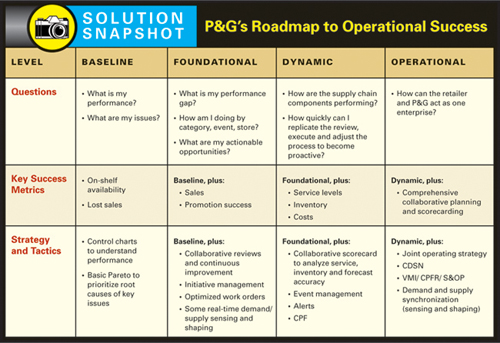P&G Leadership Puts Data to Action
 When Allan Barr took responsibility as operations manager in the drug channel at The Procter & Gamble Company (P&G) (www.pg.com) in April 2006, he began by defining success in his role; winning the "First Moment of Truth" -- the moment when the customer chooses any of P&G's 3,000 products over competitor products in thousands of U.S. drug stores. The "Second Moment of Truth" is when the consumer uses the product.
When Allan Barr took responsibility as operations manager in the drug channel at The Procter & Gamble Company (P&G) (www.pg.com) in April 2006, he began by defining success in his role; winning the "First Moment of Truth" -- the moment when the customer chooses any of P&G's 3,000 products over competitor products in thousands of U.S. drug stores. The "Second Moment of Truth" is when the consumer uses the product.Starting with a clean slate, Barr assessed "First Moment of Truth" performance -- from supply chain reliability to store execution and assortment display optimization to store design. Using P&G's shopper-centric philosophy and insights wherein "the consumer is the boss," he found in-store design and operational reliability opportunities. To improve performance and capabilities, Barr designed a multi-year project to restructure P&G's operations.
An Integrated Vision
Barr envisions an operational system fulfilling three distinct yet integrated roles: moving goods to the store (to "meet demand"); building an integrated, collaborative environment to optimize store design (to "create demand"); and finally establishing an organization capable of building, testing and commercializing continuous breakthroughs and innovation.
To enable his vision, Barr defined a four-stage roadmap that would transform capabilities from the current "baseline level" to an "operational level." Each level definition came with a list of simple questions for P&G, a set of success metrics, and the strategies and tactics employed (see Solution Snapshot).
"Any change in structural capabilities requires the analysis of
three distinct components: people, processes and technology," says Barr. "But to improve on any one of them, the first thing we had to figure out was how to measure ourselves. P&G has long used Retail Solutions (www.retailsolutions.com) to manage its point-of-sale and inventory data. This was the perfect way to assess our capabilities, set objectives and measure our progress against our long-term goals."
Improving in Stages
In the first two stages of the project, P&G primarily worked on improving in-store availability. From its initial baseline level, Barr identified three main levers to meet an aggressive availability target: promotional management, better management of phase-in and phase-out items, and shrink management. Barr utilized Retail Solutions data to first review where out of stocks happened, but more importantly to understand their root causes.
"The review of promotions was particularly insightful," comments Barr. "We found that our promotions were having greater success, but were incredibly disruptive to our supply chain, leading to unacceptable out-of-stock levels. By using retailer data to enable collaboration with supply chain partners to improve demand and supply synchronization, we improved on-shelf availability dramatically; there were examples of comparable promotions where the in-stock percentage grew 30 percent!"
During the first two stages, and in less than a year, P&G's availability reached its target level by growing more than two points and remaining there sustainably.
In the third stage, P&G leveraged data to increase sales and service while reducing inventory and cost. For instance, using a list of stores that don't scan for new product introductions, P&G deployed its retail services team to address problematic stores. For products being phased out, it identified stores with large on-hand inventory and utilized tactics such as the distribution of instantly redeemable coupons to speed up sell-through. P&G also utilized detailed sales data to identify distribution voids and ensure each store benefited from the authorized assortment. Each initiative was related to specific financial goals, with an associated increased sales forecast and a systematic measure of return on investment, thanks to P&G's ability to identify specific opportunities and deploy pinpoint resources on the issues.
Over the last three years, Barr determined that this approach enabled P&G to create an incremental 5 percent in sales, or tens of millions of dollars. "Five percent was the goal that we had set for the entire project, and we reached it one year earlier than scheduled," says Barr. "Retail Solutions Demand Signal Management is a strategy that has created value for P&G all along our transformation process. It is a critical foundation for many of the projects we run, and in this economy, having this level of business-centric visibility will be all the more important."
What's Next?
The project is still far from completion. A fourth stage focuses on building what Barr refers to as the "operational level," literally integrating P&G's and its retailers' supply chains. Based on enhanced scorecarding, this phase's focus is on-shelf management, forecasting and replenishment, and promotional/event management -- giving P&G the visibility and the tools it needs to support retailer supply chains in real time at the most granular level.
"This is the measure of real success," summarizes Barr. "We want to be in the very best position to not only react to supply chain issues, but also to make the right decisions and constantly adjust our efforts and actions based on what really happens in the store. This is the way we can maximize the opportunity retailers give us when they allocate their shelf space to our products. And if we make these right decisions, we will win the 'First Moment of Truth' more often, benefiting the shopper-consumer, the retailer and P&G."

